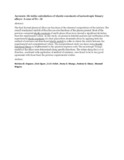| dc.contributor.author | Ongwen, Nicholas O. | |
| dc.contributor.author | Ogam, Erick | |
| dc.contributor.author | Fellah, Z.E.A. | |
| dc.contributor.author | Otunga, Henry O. | |
| dc.contributor.author | Oduor, Andrew O. | |
| dc.contributor.author | Mageto, Maxwell | |
| dc.date.accessioned | 2023-07-06T11:21:12Z | |
| dc.date.available | 2023-07-06T11:21:12Z | |
| dc.date.issued | 2022-09-15 | |
| dc.identifier.uri | https://doi.org/10.1016/j.ssc.2022.114879 | |
| dc.identifier.uri | https://www.sciencedirect.com/science/article/abs/pii/S003810982200206X?via%3Dihub | |
| dc.identifier.uri | http://ir-library.mmust.ac.ke:8080/xmlui/handle/123456789/2249 | |
| dc.description.abstract | The final formed phases of alloys are functions of the chemical compositions of the mixture. The overall mechanical moduli of the alloy are also functions of the phases present. Most of the previous computed elastic constants of multi-phase alloys have showed a significant deviation from the experimental values. In this study, we present a detailed analysis and verification of the experimental elastic constants of a dual-phase ferro aluminide alloys by applying both the method of mixtures and directional elastic moduli in order to obtain the match between the experimental and computational values. The computational study was done using density functional theory as implemented in the quantum espresso code. The anisotropic Young's moduli of the alloys were determined along specific directions. The values along the (1 0 0) direction, combined with application of method of mixtures, were found to be in very good agreement with those from the previous experimental studies. | en_US |
| dc.language.iso | en | en_US |
| dc.publisher | Solid State Communications | en_US |
| dc.subject | Accurate, Ab-initio, calculation, elastic, constants, anisotropic, binary alloys, case,Fe–Al | en_US |
| dc.title | Accurate Ab-initio calculation of elastic constants of anisotropic binary alloys: A case of Fe–Al | en_US |
| dc.type | Article | en_US |

